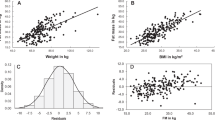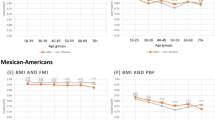Abstract
Obesity is a major risk factor for diabetes and related disorders. The current classification of obesity is based on body mass index (BMI, kg/m2), which is a surrogate for the total body fat. Since the relationship between BMI and body fat varies in different populations, an independent validation of the BMI–body fat relationship in the population of interest is desirable.
OBJECTIVES:
(1) To study the validity of field methods of measuring body fat (multiple skinfolds and bioimpedance) against a criterion method (deuterium dilution) and (2) To compare the prevalence of obesity (WHO 2000 criteria for BMI) with adiposity (body fat >25%) in middle-aged Indian men in rural and urban Pune.
DESIGN:
Community-based multistage stratified random sampling of middle-aged men from rural and urban Pune for study of body composition and cardiovascular risk. A third of these men, selected to represent wide BMI distribution, were studied for body fat measurements by specific methods.
SUBJECTS:
A total of 141 healthy men, approximately similar number from rural, urban slums and middle class from Pune. They were 39.3 (±6.2) y old and had a BMI of 21.9 (±3.7) kg/m2.
MEASUREMENTS:
Anthropometry (height, weight and multiple skinfold thicknesses) by trained observers using standardised technique to calculate body fat by Durnin and Womersley's equation. Total body water and body fat by bioelectrical impedance analysis (BIA) and deuterium oxide dilution (D2O).
RESULTS:
Mean total body fat was 14.3 kg (23.0%) by anthropometry, 16.5 kg (26.0%) by BIA and 15.3 kg (24.6%) by D2O method. Although there was a good correlation between fat estimation by three methods (r=∼0.9, P<0.001 all), compared to D2O method anthropometry underestimated body fat by 1.0 kg and BIA overestimated fat by 1.2 kg (P<0.001 both). Using the standard cut-point of 25% body fat for ‘adiposity’ 29.5% rural, 46.0% slum and 75.0% middle class men were adipose. These proportions were considerably higher than the number of men who were ‘preobese’ (BMI≥25–29.9 kg/m2, 9.0% rural, 22.0% urban slums and 27.0% urban middle class) and ‘obese’ (BMI >30 kg/m2, 4.0% urban slums, none in rural and urban middle class).
CONCLUSION:
We recommend that future studies assessing risk for chronic diseases in Indians should measure adiposity by anthropometry (multiple skinfolds) or BIA (calibrated for Indians) rather than relying only on BMI cut-points.
This is a preview of subscription content, access via your institution
Access options
Subscribe to this journal
Receive 12 print issues and online access
$259.00 per year
only $21.58 per issue
Buy this article
- Purchase on Springer Link
- Instant access to full article PDF
Prices may be subject to local taxes which are calculated during checkout



Similar content being viewed by others
References
Ramaiya KL, Kodali VR, Alberti KGMM . Epidemiology of diabetes in Asians of Indian subcontinent. Diab Metab Rev 1990; 6: 125–146.
Ramachandran A, Snehalatha C, Kapur A, Vijay V, Mohan V, Das AK, Rao PY, Yajnik CS, Prasanna Kumar KN, Nair JD, Diabetes Epidemiology Study Group in India (DESI). High prevalence of diabetes and impaired glucose tolerance in India: National Urban Diabetes Survey. Diabetologia 2001; 44: 1094–1101.
Gupta R, Gupta VP . Meta-analysis of coronary heart disease prevalence in India. Ind Heart J 1996; 48: 241–245.
Obesity: preventing and managing the global epidemic: Report of a WHO Consultation. Geneva, World Health Organization; 2000. (Technical Report Series 894) p 9.
Shetty PS, James WPT . Body mass index- a measure of chronic energy deficiency in adults. Rowett research institute. FAO Food and Nutrition Paper 56, 1994. Rome Ed. Aberdeen, UK.
Garrow JS, Webster J . Quetelet's Index (W/H2) as a measure of fatness. Int J Obes 1985; 9: 779–792.
Norgan NG . Population differences in body composition in relation to BMI. Eur J Clin Nutr 1994; 48: S10–S27.
Chowdhury B, Lantz H, Sjostrom L . Computed tomography-determined body composition in relation to cardiovascular risk factors in Indian and matched Swedish males. Metabolism 1996; 44: 634–644.
Deurenberg P, Yap M, Staveren van WA . Body mass index and percent body fat: a meta-analysis among different ethnic groups. Int J Obes Relat Metab Disord 1998; 22: 1164–1171.
Banerji MA, Faridi N, Chaikn RL, Lebovitz HE . Body composition, visceral fat, leptin, and insulin resistance in Asian Indian men. J Clin Endocrinol Metab 1999; 84: 137–144.
Chandalia M, Abate N, Garg A . Relationship between generalized and upper body obesity to insulin resistance in Asian Indian men. J Clin Endocrinol Metab 1999; 84: 2329–2335.
Deurenberg-Yap M, Schmidt G, Staveren WA, Deurenberg P . The paradox of low body mass index and high body fat percent among Chinese, Malays and Indians in Singapore. Int J Obes Relat Metab Disord 2000; 24: 1011–1017.
Deurenberg-Yap M, Schmidt G, van Staveren WA, Hautvast JG, Deurenberg P . Body fat measurement among Singaporean Chinese, Malays and Indians: a comparative study using a four-compartment model and different two-compartment models. Br J Nutr 2002; 85: 491–498.
Yajnik CS, Fall CHD, Coyaji KJ, Hirve SS, Rao S, Barker DJP, Joglekar C, Kellingray S . Neonatal anthropometry: The thin-fat Indian baby, The Pune Maternal Nutrition Study. Int J Obes Relat Metab Disord 2003; 26: 173–180.
Yajnik CS, Yudkin JS . Y-Y paradox. Lancet 2004; 363: 163.
Deurenberg P . The assessment of body composition: use and misuse. Annu Rep Nestlé Found 1992; 35–72.
Schoeller DA . Hydrometry. In: Roche AF, Heymsfield SB, Lohman TG (eds.) Human body composition. Human Kinetics: Champaign, IL; 1996. pp. 25–43.
Fuller NJ, Jebb SA, Laskey MA, Coward WA, Elia M . Four compartment model for the assessment of body composition in humans: comparison with alternative methods, and evaluation of the density and hydration of fat free mass. Clin Sci 1992; 82: 687–693.
Lubree HG, Rege SS, Bhat DS, Raut KN, Panchanadikar AN, Joglekar CV, Yajnik CS, Shetty P, Yudkin J . Body fat and cardiovascular risk factors in Indian men in three geographical locations. Food and Nutr Bull 2002; 23: 146–149.
Prentice AM . The doubly labelled water method for measuring energy expenditure: Technical recommendation for use in humans. (A consensus report by the IDECG Working group, Vienna, 1990). Section 3.5.1. ii: 27.
Borgonha S, Pitracchi C, Ferro Luzzi A, Shetty PS, Kurpad AV . Prediction of total body water in Indian men from anthropometry and bioelectrical impedance using deuterium dilution as reference. Ann Hum Biol 1997; 24: 355–361.
Coward A . Calculation of pool sizes and flux rates. In: Prentice AM (ed). The doubly labelled water method for measuring energy expenditure: Technical recommendations for use in humans. IAEA: a consensus report by the IDGCG Working Group, Vienna 1990. Section 4.3.2:59 & Appendix 2.
Wang Z, Deurenberg P, Heymsfield DB . Cellular-level body composition model. A new approach to studying fat-free mass hydration. Ann N Y Acad Sci 2000; 904: 306–311.
Durnin JVGA, Womersley J . Body fat assessed from total body density and its estimation from skinfold thickness: measurement on 481 men and women aged from 16 to 72 years. Br J Nutr 1974; 32: 77–97.
Siri WE . Body composition from fluid spaces and density: analysis of methods. In: Brozek J and Henschel A (eds) Techniques for measuring body composition. National Academy of Sciences NRC: Washington, DC; 1961; 223–244.
NIH technological assessment statement. Bioelectrical impedance analysis in body composition measurement. U.S.D.H.H.S: Bethesda, USA; 1994. pp 1–35.
Bland JM, Altman DG . Statistical methods for assessing agreement between two methods of clinical measurement. Lancet 1986; I: 307–310.
Singh RB, Naiz MA, Beegom R, Wander GS, Thakur AS, Rissam HS . Body fat percent by bioelectrical impedance analysis and risk of coronary artery disease among urban men with low rates of obesity: the Indian paradox. J Am College Nutr 1999; 18: 268–273.
Kurpad AV, Borgonha S, Shetty PS, Ferro-Luzzi A . Body composition of chronically energy deficient human males by a 3 compartment model. Ind J Med Res 1999; 109: 56–66.
McKeigue PM, Shah B, Marmot MG . Relation of central obesity and insulin resistance with high diabetes prevalence and cardiovascular risk in Asians. Lancet 1991; 337: 382–386.
Deurenberg P, Westrate JA, Seidell JC . Body mass index as a measure of body fatness: age- and sex-specific prediction formulas. Br J Nutr 1991; 65: 105–114.
Yajnik CS, Shelgikar KM, Naik SS, Sayyad MG, Raut KN, Bhat DS, Deshpande JA, Kale SD, Hockaday TDR . Impairment of glucose tolerance over 10 yr in normal glucose tolerant Indians. Diabet Care 2003; 26: 2212–2213.
Snehalatha C, Vishwanathan V, Ramachandran A . A cutoff values for normal anthropometric variables in Asian Indian adults. Diabet Care 2003; 26: 1380–1384.
WHO Expert Consultation. Appropriate body-mass index for Asian populations and its implications for policy and intervention strategies. Lancet 2004; 363: 157–163.
Acknowledgements
We are grateful to all the subjects who participated in the CRISIS study. Nestle Foundation, Lausanne, Switzerland and the International Atomic Energy Agency; Vienna, Austria provided financial support. We would like to thank social workers, Mr TM Deokar, Mr AJ Bhalerao, Mr VA Solat and Mr AB Gaikwad for their hard work. Mr CV Joglekar helped in data management and Mrs PC Yajnik provided administrative supervision.
Author information
Authors and Affiliations
Corresponding author
Rights and permissions
About this article
Cite this article
Bhat, D., Yajnik, C., Sayyad, M. et al. Body fat measurement in Indian men: comparison of three methods based on a two-compartment model. Int J Obes 29, 842–848 (2005). https://doi.org/10.1038/sj.ijo.0802953
Received:
Revised:
Accepted:
Published:
Issue Date:
DOI: https://doi.org/10.1038/sj.ijo.0802953
Keywords
This article is cited by
-
Criterion-Related Validity of Field-Based Methods and Equations for Body Composition Estimation in Adults: A Systematic Review
Current Obesity Reports (2022)
-
Is vulnerability to cardiometabolic disease in Indians mediated by abdominal adiposity or higher body adiposity
BMC Public Health (2014)
-
Re-evaluation of WHO-defined BMI cutoff value for defining overweight and obesity in the Bengalee (Indian) population
Mediterranean Journal of Nutrition and Metabolism (2013)
-
Catch up growth in low birth weight infants: Striking a healthy balance
Reviews in Endocrine and Metabolic Disorders (2012)
-
Prediction of body-fat percentage from skinfold and bio-impedance measurements in Indian school children
European Journal of Clinical Nutrition (2011)



